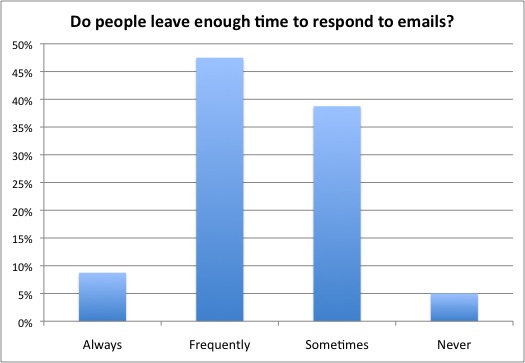How often do you feel people leave you sufficient time to respond to an email? Results from client projects suggest nearly half of us feel that people do not leave sufficient time to respond properly.

To participate in the full survey with a chance to win a free copy of ‘Brilliant Email’ – click on this link ‘Time to Respond’ survey.
Not being left suffient time to respond can be quite challenging especially when a substantive response is needed which requires thought and perhaps some background research. Why do we leave other people so little time to respond? Is it:
Whatever the reason, unreasonable expectations up the email stress on the person of whom we ask for a quick response. Further the pressure to responde often results in costly mistakes. For example, we admit to errors, give wrong facts, commit to deadlines and tasks which are not achievable etc.
What can be done to change the culture and make time for people to give an adequate reliable response? First and foremost, ask yourself how long it would take you to respond. Now double it (as we always over estimate our personal abilities) and that is the time you need to allow the other person to respond. That is good email etiquette.
Second as the recipient, to take the heat out of the situation, decide how quickly you can respond and if it is not within a working day, tell the sender. Tell them when you will respond. Don’t ask if it’s OK. You decide and set the time frame. Again use good email etiquette to manage the situation.
Third as a sender check people availablity beforehand and agree what is a reasonable response time.
For more tips and hints on ways to leave time for the recipient and as the recipient take the pressure off you to respond, follow me on Twitter.
Meanwhile what are your favourite tips on how to reduce the email overload and email stress created by those who expect an instant response?
Tags: email best practice, email etiquette, email overload, email stress
Two more reports now suggest that social media as an alternative to email is not growing as fast as it should: Radicati Group’s latest industry survey and informal research from Brian Solis. This despite the fact that Facebook and Twitter usage continues to grow. Meanwhile for business, as IBM found, email is still the preferred media. Even although the IBM study found that 48% of respondents felt they suffered from email overload.
Why is this? One explanation might be the Generation X and Y. By and large business is still tilted towards more Generation X employees many of whom are not comfortable with social media and have not been educated how to use it properly. A second explanation might be that all alerts about new information on social media/social networks still comes by email. This in turn drives up the email traffic. One way to manage this aspect of email overload is to create rules to divert all such alerts away from the inbox and to a folder.
However that still leaves the need to educate Generation X.
What do you think?
Tags: email management, email overload, email stress